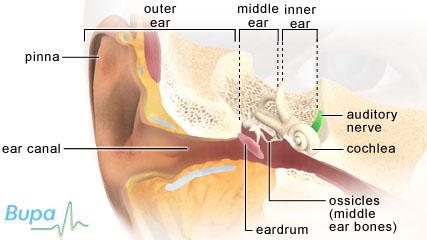Hearing aids

This factsheet is for people who are considering getting a hearing aid, or who would like information about them.
Hearing aids are electronic devices that are worn either in or behind your ear. They make sounds louder and clearer so that you hear them comfortably if you're having problems with your hearing.
Availability and use of hearing aids may vary from country to country.
How the ear works
About hearing aids
Wearing a hearing aid
Caring for a hearing aid
Living with a hearing aid
How the ear works
About hearing aids
A hearing aid is a small device that you wear in or behind your ear. It can make some sounds louder so that you can communicate more effectively. If you're having problems with your hearing, a hearing aid may help increase how much you can hear. Hearing loss is common and can affect people of any age. According to the World Health Organization, hearing loss and deafness affects at least 275 million people worldwide.
A hearing aid can help if your hearing loss has been caused by damage to the hair cells in your inner ear (sensorineural hearing loss). It may also be helpful for some types of conductive hearing loss – where sound is unable to pass from your outer ear to your inner ear because of a build-up of wax, or because you have fluid in your ear. If you have tinnitus (buzzing or ringing in your ears), a hearing aid may help you to notice it less.
Having a hearing test
If you think a hearing aid may help with your hearing, speak to a doctor for more advice. He or she may refer you to an audiologist (a healthcare professional who specialises in identifying and treating hearing disorders). You will need to have a hearing test to find out what sort of hearing loss you have and whether or not a hearing aid will be helpful.
Your audiologist will ask you questions about your hearing and examine your ears. He or she will ask you to listen to sounds through headphones at different pitches and volumes. Every time you hear a sound, you press a button.
The audiologist may then ask you to wear a headband with a vibrating pad that transmits sounds to the cochlea in your inner ear on both sides of your head. The cochlea turns sounds into nerve impulses and sends them to your brain, which interprets the vibrations as sounds. Again, you press a button each time you hear something.
For children under the age of four, it can be difficult to get reliable results with these techniques, so a paediatric audiometric assessment can be used, which often requires more than one audiologist and can take longer.
Your audiologist will discuss your test results with you and advise you if a hearing aid is likely to help you, or if a different treatment will be more beneficial.
Please note that availability and use of specific tests may vary from country to country.
How hearing aids work
A hearing aid is made up of a microphone, amplifier and speaker. The microphone picks up sounds and converts the sound waves into electrical signals that are sent to the amplifier. The amplifier makes the sounds louder and sends them to your ear through the speaker.
Your hearing aid can be tuned into certain sounds you're struggling to hear without making noises that are already loud even louder.
Hearing aids won't make your hearing perfect but will help you hear everyday sounds like the telephone, doorbell and kettle boiling.
Types of hearing aid
Hearing aids are available in analogue and digital and come in various shapes and sizes.
Analogue hearing aids
Analogue hearing aids are traditional hearing aids that use a transistor (a device that increases the power of a signal) to increase the volume of the sounds picked up by the microphone. Your audiologist will set the hearing aid so that the sounds you're having difficulty hearing are made louder and sent into your ear through the speaker.
Analogue hearing aids are usually cheaper than digital ones, but have almost been completely replaced by digital aids, which are easier to customise to your needs.
Digital hearing aids
Digital hearing aids contain a mini-computer. Sounds picked up by the microphone are first broken up into very small, distinct units. The mini-computer is programmed to make some of the units louder and some of the units quieter depending on your specific hearing difficulty. Some digital hearing aids can be adjusted to suit different situations, such as a quiet library or a noisy bar.
Most hearing aid manufacturers only produce digital hearing aids.
Wearing a hearing aid
There are a number of different styles of hearing aid. The style you have will determine where you wear your hearing aid. Some examples are listed below.
- Behind-the-ear hearing aids have a plastic case that sits behind your ear and an earmould that fits into your outer ear. Open fit, behind-the-ear hearing aids have a narrow tube that inserts into your ear canal instead of an earmould. This leaves your ear canal open so is a good choice if you tend to get a build-up of earwax. It can make sounds more natural. Open fit, behind-the-ear hearing aids are suitable if you have mild to moderate hearing loss.
- In-the-ear hearing aids fit entirely within your outer ear and may be used if you have mild to severe hearing loss. These hearing aids are usually less noticeable than behind-the-ear hearing aids. Some in-the-ear hearing aids have a part called a telecoil that makes telephone conversations easier to hear. In-the-ear hearing aids aren't generally used by children because the casings need to be replaced as their ear grows.
- Canal hearing aids fit into your ear canal and come in two styles. In-the-canal hearing aids are made to fit the size and shape of your ear canal. Completely-in-canal hearing aids are smaller and less visible than other styles of hearing aid. They are almost totally hidden inside your ear canal. Canal hearing aids may not be suitable if you have severe hearing loss or have frequent ear infections. This is because they are very small and can't hold a very powerful amplifier.
- You may benefit from a bone conduction hearing aid if you have conductive hearing loss and you're unable to wear one of the more common styles of hearing aid. This could be because you have had ear canal or middle ear problems, such as frequent ear infections or surgery. Bone conduction hearing aids work by passing sound through your skull directly to your inner ear, missing out your outer and middle ear.
- If you have vision problems or find it difficult to work small controls, you may find a hearing aid that you wear on your body useful. This type of hearing aid has a small box that you can put in your pocket or attach to your clothes. The box is connected to a microphone by a lead, which can be very powerful.
Caring for a hearing aid
Your audiologist will give you instructions about how to care for your hearing aid so that it works well and lasts as long as possible. You may find the following tips helpful.
- Wash your behind-the-ear hearing aid every night in warm soapy water.
- Clean your in-the-ear hearing aid regularly with a soft, dry cloth to remove any earwax. It's important that your in-the-ear hearing aid doesn't come into contact with any liquid.
- When you're not wearing your hearing aid, store it carefully in a box in a cool, dry place.
- Turn off your hearing aid when you're not using it.
- Change the batteries as soon as they stop working.
Living with a hearing aid
You may find it takes a while to get used to wearing a hearing aid. It's important to wear it as much as possible and practise using the controls and different settings. Your audiologist will be able to give you advice about using your hearing aid in different environments. He or she can also help if you have any problems with your hearing aid.
Can I go swimming with a hearing aid?
Will I need hearing aids in both ears?
What happens during a hearing test?
Can I go swimming with a hearing aid?
Answer
No, you will need to remove your hearing aid when you go swimming.
Explanation
It’s important to keep your hearing aid dry as water can damage the electronic parts and the battery. Therefore, you will need to take it out when you go swimming and either remove it or be careful to keep it dry when having a shower or bath. There are some manufacturers who have developed hearing aids that are said to be water resistant, but generally you’re advised to also remove these before going swimming.
If you have a bone anchored hearing aid (BAHA), it’s important to remove the external sound processor before going swimming.
Further information
Deafness Research UK
0808 808 2222
www.deafnessresearch.org.uk
Royal National Institute for Deaf People (RNID)
0808 808 0123
www.rnid.org.uk
Sources
- Personal communication, Dr S S Surenthiran, consultant neuro-otologist, Balance and Hearing Centre, Fitzroy Square Hospital, London, 31 December 2009
Will I need hearing aids in both ears?
Answer
You may do. It depends on whether you have hearing loss in one or both ears, and how severe this is.
Explanation
If you have hearing loss in both ears, you will probably find it more helpful to have two hearing aids. This will make it easier to identify where sounds are coming from and also to hear people talking when there is background noise.
However, you may only need one hearing aid if your hearing loss is in one ear or if it’s much worse in one ear than the other. Your audiologist (a healthcare professional who specialises in identifying and treating hearing disorders) can give you advice and information about whether one or two hearing aids are best for you.
Further information
Deafness Research UK
0808 808 2222
www.deafnessresearch.org.uk
Royal National Institute for Deaf People (RNID)
0808 808 0123
www.rnid.org.uk
Sources
- Hearing aids. National Institute on Deafness and Other Communication Disorders. www.nidcd.nih.gov, April 2007
- Getting hearing aids. RNID. www.rnid.org.uk, accessed 18 November 2009
What happens during a hearing test?
Answer
A hearing test usually involves listening to different sounds through headphones and recording when you hear them.
Explanation
Testing the hearing is known as audiometry. You will need to have a hearing test to show your audiologist (a healthcare professional who specialises in identifying and treating hearing disorders) what sort of hearing loss you have and how it can best be treated. The results will help him or her work out if a hearing aid will be suitable for you, and if so, what type.
Your audiologist will first ask you questions about your hearing and look in your ears. You will then be given headphones to wear and a series of sounds will be played. These will be tones of different pitch and volume, and they will gradually get quieter. Your audiologist will test one ear at a time and ask you to press a button when you hear a sound.
Further information
Deafness Research UK
0808 808 2222
www.deafnessresearch.org.uk
Royal National Institute for Deaf People (RNID)
0808 808 0123
www.rnid.org.uk
Sources
- Getting hearing aids. RNID. www.rnid.org.uk, accessed 18 November 2009
Related topics
Hearing aids
Cochlear implants
Hearing loss
Tinnitus
Related topics
Cochlear implants
Hearing loss
Tinnitus
Further information
Deafness Research UK
0808 808 2222
www.deafnessresearch.org.uk
Royal National Institute for Deaf People (RNID)
0808 808 0123
www.rnid.org.uk
Sources
- Facts and figures about deafness in the UK. Deafness Research UK. www.deafnessresearch.org.uk, published 3 April 2009
- Hearing loss. PubMed Health. www.nlm.nih.gov/pubmedhealth, published 31 May 2011
- What is tinnitus? Deafness Research UK. www.deafnessresearch.org.uk, published 7 February 2008
- Hearing aids. National Institute on Deafness and Other Communication Disorders. www.nidcd.nih.gov, published 1 April 2007
- Analogue hearing aid. The National Deaf Children's Society. www.ndcs.org.uk, published 29 December 2008
- Digital hearing aid. The National Deaf Children's Society. www.ndcs.org.uk, published 29 December 2008
- Types of hearing aids. Action on Hearing Loss. www.actiononhearingloss.org.uk, accessed 26 October 2011
- Hearing aids and how to get one. ENTUK. www.entuk.org, accessed 31 October 2011
- Personal communication, Dr SS Surenthiran, Consultant Neuro-otologist, Fitzroy Square Hospital, 25 October 2011
- Deafness and hearing impairment. World Health Organization. www.who.int, published February 2012
Produced by Dylan Merkett, Bupa Health Information Team, April 2012.
















